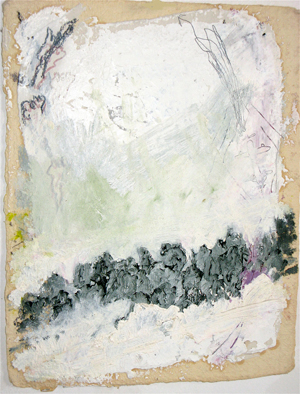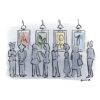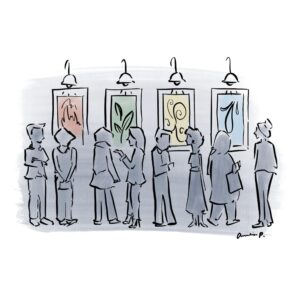
Art objects have long been the centerpiece of many a tale of intrigue. There are innumerable stories replete with counterfeiting, stealing, high stakes trading, and political maneuvering à la the Barnes Collection, any one of which could (if it hasn’t already) be made into a fast-paced Hollywood blockbuster.
This is not one of those.
It’s an account of a network of people moving through never-before-codified social interactions in a way that doesn’t harm anyone, isn’t meant to disrupt the market, and doesn’t lay claims to a grounding in theory, Marxist or otherwise (though ideas like Marcel Mauss’s gift economy and Pierre Bourdieu’s cultural heritage have been applied to the organization post-creation). This is the Fine Art Adoption Network (F.A.A.N.): a quiet, consistent online space where a less moneyed collector such as myself can use her love of art as a kind of currency, and an artist who wishes to engage in a more wholesome type of exchange can find pleasure in gifting a select work. At least, that’s one experience of it. Every interaction is different. Institutions and more traditional collectors also frequent the site—it’s really up to the individual artists to choose who, if anyone, gets to own their work, and why.
The Brooklyn-based painter Adam Simon started F.A.A.N. in 2006, after receiving financial backing from the then-new commissions program at Art in General. Simon prefers to look at the network not as some sort of intentional social sculpture but as a natural outgrowth of his work as a painter. The idea that this kind of social project is historically at odds with an object-oriented studio practice seems to weigh on him, but the ease with which F.A.A.N. fits into today’s art world reflects the waning ghettoization of forms. In a sense, it is the perfect performance document. By imbuing art objects with the essence of a progressive social experiment and performative life event, an object transcends, even further, the materials with which it was created.
Simon doesn’t talk in these grandiose terms, however. He’s pragmatic, down-to-earth, with the kind of intelligence that naturally sorts through all the muddled motivations and systematic pitfalls in a place like the art world and comes up with solutions that can only be defined with words like “simple” and “good.” There have been and are highly visible artists participating in F.A.A.N. (notably Amy Sillman, who set a precedent by refusing a major museum’s bid for adoption in favor of an artist named Peter Ferko, who runs the nonprofit Artists Unite and who wrote to her: “I sleep. I dream of heads moving across a canvas. One is obscured by an orange square…”) But there are also a lot of good artists on F.A.A.N. (as there are in Brooklyn and all over the world) who, as Simon remarks, “will never really sell a lot of work and never really show up in the history books.” It occurred to him at some point, that “when they look back on their lives, they’re going to see their epiphanies in the studio and they will have some objects that they think are really great, but they’re also going to look back on a lot of social interaction—that’s a really big part of being an artist. It’s a lot of talking.” A big part of F.A.A.N. is facilitating a certain kind of heavily invested art talk—whetted by the potential of actual art ownership—between artists and a diversified, less exclusive set of collectors.
When I went to Nancy Brett’s top floor SoHo loft one morning to pick up the painting that I had requested for “adoption” on F.A.A.N. via an email exchange with the artist, natural light was flooding the large space; the works on the white studio walls had me a bit stunned. I knew before I arrived that I liked her abstract, organically grid-based paintings, but my immediate and emotional attachment to her body of work surprised me. The name of the network, like the language many collectors use to describe their art pieces—“members of my family,” etc.—started to make a little more sense.
Brett and I had what felt like a very delicate, respectful conversation about the process as we acted it out. She described how nice it was to hear someone directly saying that not only did she like the work, but that she wanted to have it in her life: “Because that’s what I would hope for my work. Since it’s not going to be in my life anymore, that it would be somewhere where it would be appreciated. I think you assume that when something is collected in a gallery, but you don’t really know what someone’s reason for collecting it is. You don’t know if they want to have it in their life, which is the biggest commitment of all, much more than the expense of it. Incorporating it into your mentality, your consciousness; it changes your life in some way.” We also talked about New York and Los Angeles, and what it means to be a parent, an artist, and a woman. I told her I liked her shoes. We talked about how great the idea of veganism is, but how difficult it is never to eat cheese. She carefully wrapped up the painting, and gave it to me.
Simon tends to describe the origins of F.A.A.N. as a solution to a storage problem: too much good art in the world without a useful enough system of distribution in place. He refers to the vault that Al Held had carved in the side of a mountain to hold all the paintings he had in his possession at the end of his life: “Even if you’re successful, you still accumulate a lot of objects.” And he self-deprecatingly exaggerates his anxieties about the burden his own paintings may become for his son some day. But F.A.A.N. is not about moving large volumes of work; it was created with a huge respect for each individual object, and the process takes time, energy, and real emotional investment for all parties involved. It’s not a process that makes sense in the (art) world as we know it, but maybe we’re all just unnaturally accustomed to bureaucracy, competition, and padlocked doors. When I left Brett’s studio that day, painting in hand, the air just beginning to taste crisp in that late morning, mid-September New York way, I felt lighter for my new possession, and pleasantly, hopefully, confused.
This post was originally published on this site be sure to check out more of their content


